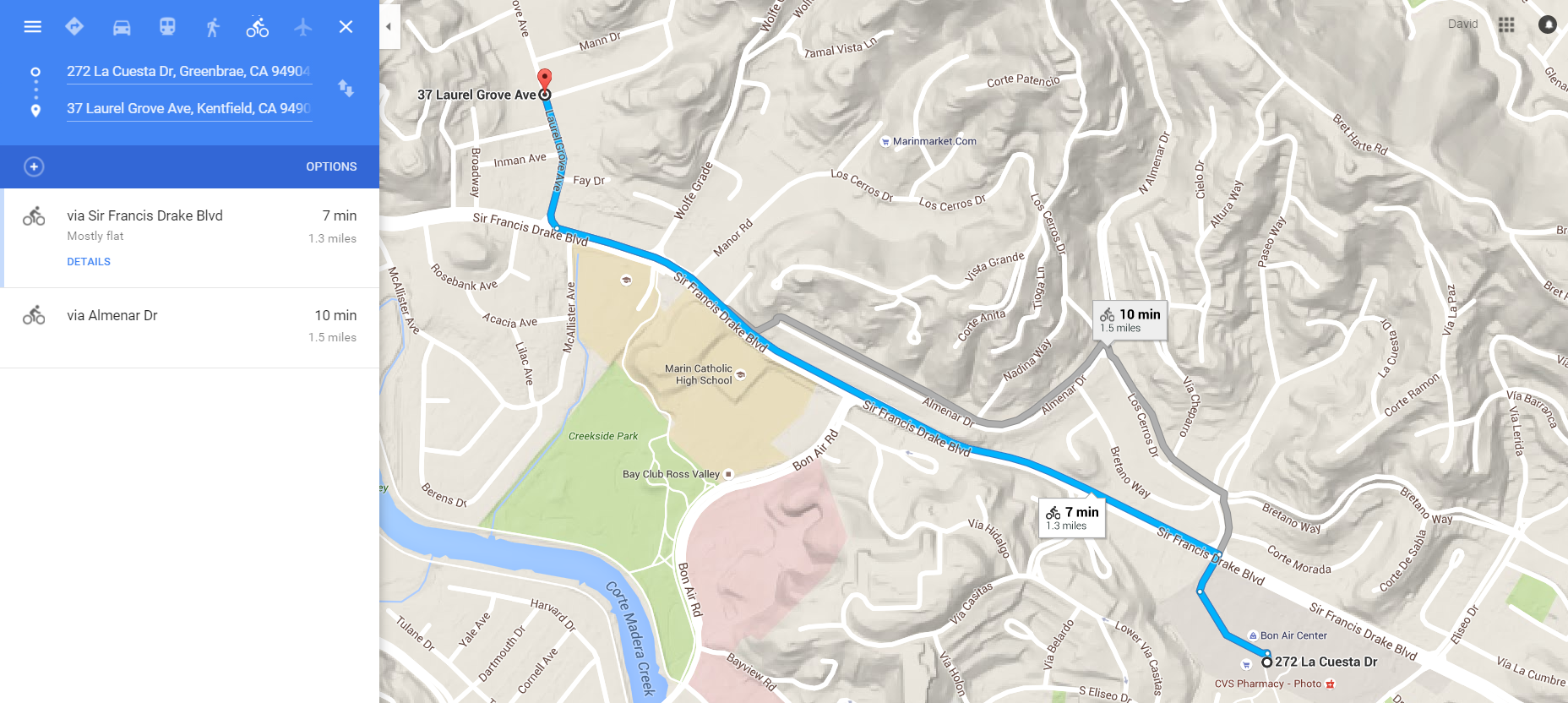This holds true for other corridors, and it’s not surprising. Since the rise of the car, arterial roads have become the backbone of our commercial economy. Quiet streets are saved for our showpiece downtowns and residential neighborhoods while high-speed roads serve our everyday shops, like supermarkets, banks, retailers, doctor’s offices, post offices, coffee shops, and the like. By pushing bikes off the high-speed streets, we effectively take biking off the list of acceptable ways to get around for everyday errands.
And there are the benefits of network effects. Though each individual project might not add much to bike ridership, building a complete network will mean every completed segment will add to the usefulness of every other segment. One fax machine is a paperweight. A fax machine in every office, however, makes that one machine very useful. A new safe bike lane on Sir Francis Drake is useful to those living near it. Another one on Corte Madera’s Tamalpais Avenue is useful to those living near that street.
Add a link to Redwood Highway and suddenly you have a network, making both Tamalpais Avenue, Redwood Highway, and Sir Francis Drake useful to anyone along any of those routes while also adding value to the Corte Madera Creek path and the Sandra Marker trail. Any other links – like Bon Air Road or San Anselmo’s Red Hill Avenue – expand the capabilities of the formerly isolated segments even further.
This is backed up by research. Jessica Schoner and David Levinson of the University of Minnesota found that “connectivity and directness are important factors in predicting bicycle commuting after controlling for demographic variables and the size of the city” (Schoner & Levinson, 2014) Since commuting is a minority of trips, and these high-speed roads are also lined with shops and services, the effect on overall trips by bicycle will be larger than expected.
As well, Schoner and Levinson didn’t differentiate between the quality of the bike link, whether it’s a painted bike lane, an off-road path, or a protected lane like what I propose. Other studies (Heinen, Maat, & van Wee, 2011; Tilahun, Levinson, & Krizek, 2007; Wardman, Tight, & Page, 2007) have found that the quality of the bike lane has a meaningful impact on bike-to-work rates; Heinan, Maat & van Wee found this was especially true for short trips. These strongly imply that safer lanes will have a meaningful impact on non-work trips, especially on short trips.
The safety problem
The principal objection to having a protected bicycle lane on a high-speed road was one of safety. Commenter Ann Becker remarked, “A heavily traveled street with traffic going at speeds of up to 40 mph is simply not safe for bike riders, either school age or older.”
Research does not bear out Becker’s assertion. New York City’s Department of Transportation released research indicating traffic collision injuries dropped by an average of 20 percent following the installation of protected bike lanes along major avenues (Miller, 2014), which are often just as unfriendly to people on bikes as Sir Francis Drake. Other studies (Harris et al., 2013; Lusk et al., 2011; Teschke et al., 2012) have found even more significant drops in injury crashes to all road users, including drivers, after the installation of protected bicycle lanes. This holds true even on fast streets like Sir Francis Drake.
All this assumes we agree that bicycling is good for the environment, good for physical and mental health, and good for the economy (Maus, 2012), and it is indeed all those things. Given that a strong network encourages bicycling while also improving road safety, there is no reason to keep protected bicycle lanes off the road, even high-speed roads. As I laid out two weeks ago, we can add protected bicycle lanes to Sir Francis Drake without sacrificing any eastbound lanes. With the heavy weight of evidence, we can further add that this would be of huge benefit to anyone who lives, works, shops, or drives along that boulevard.
Works Cited
In keeping with my university's standards, future blog posts will use in-text citations and a works cited. Often, these will be behind a paywall; please email me at thegreatermarin@gmail.com if you would like the full text.
Harris, M. A., Reynolds, C. C. O., Winters, M., Cripton, P. A., Shen, H., Chipman, M. L., … Teschke, K. (2013). Comparing the effects of infrastructure on bicycling injury at intersections and non-intersections using a case–crossover design. Injury Prevention, 19(5), 303–310. http://doi.org/10.1136/injuryprev-2012-040561
Heinen, E., Maat, K., & van Wee, B. (2011). The role of attitudes toward characteristics of bicycle commuting on the choice to cycle to work over various distances. Transportation Research Part D: Transport and Environment, 16(2), 102–109. http://doi.org/10.1016/j.trd.2010.08.010
Lusk, A. C., Furth, P. G., Morency, P., Miranda-Moreno, L. F., Willett, W. C., & Dennerlein, J. T. (2011). Risk of injury for bicycling on cycle tracks versus in the street. Injury Prevention, ip.2010.028696. http://doi.org/10.1136/ip.2010.028696
Maus, J. (2012, July 6). Study shows biking customers spend more. Retrieved from http://bikeportland.org/2012/07/06/study-shows-biking-customers-spend-more-74357
Miller, S. (2014, September 5). New DOT Report: Protected Bike Lanes Improve Safety for Everyone. Retrieved from http://www.streetsblog.org/2014/09/05/new-dot-report-shows-protected-bike-lanes-improve-safety-for-everybody/
Schoner, J. E., & Levinson, D. M. (2014). The missing link: bicycle infrastructure networks and ridership in 74 US cities. Transportation, 41(6), 1187–1204. http://dx.doi.org.proxy.library.cornell.edu/10.1007/s11116-014-9538-1
Teschke, K., Harris, M. A., Reynolds, C. C. O., Winters, M., Babul, S., Chipman, M., … Cripton, P. A. (2012). Route infrastructure and the risk of injuries to bicyclists: a case-crossover study. American Journal of Public Health, 102(12), 2336–2343. http://doi.org/10.2105/AJPH.2012.300762
Tilahun, N. Y., Levinson, D. M., & Krizek, K. J. (2007). Trails, lanes, or traffic: Valuing bicycle facilities with an adaptive stated preference survey. Transportation Research Part A: Policy and Practice, 41(4), 287–301. http://doi.org/10.1016/j.tra.2006.09.007
Wardman, M., Tight, M., & Page, M. (2007). Factors influencing the propensity to cycle to work. Transportation Research Part A: Policy and Practice, 41(4), 339–350. http://doi.org/10.1016/j.tra.2006.09.011


![Historic-Railways-of-the-DMV-[Recovered].jpg](https://images.squarespace-cdn.com/content/v1/554110c7e4b0512f43ca0881/1452635654593-YY1MQ1M6GC1TW310JCPG/Historic-Railways-of-the-DMV-%5BRecovered%5D.jpg)






























